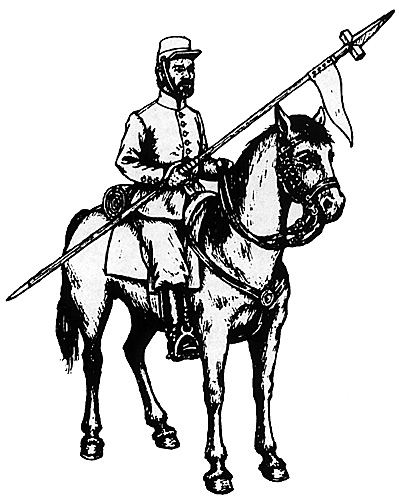FIG.7: Trooper, 1st National Guard Cavalry Regiment, "Of The Court", Full Dress, 1858: Steel helmet with brass crest, front badge and chin-scales, red horse-hair mane. Dark blue coatee with white collar and cuff flaps, both edged with red piping as are the dark blue cuffs and front opening, brass buttons and shoulder-scales, red turnbacks, 2 yellow lace loops on either side of the collar. Dark blue trousers with red double stripe, white belts with brass or gilded fittings, white gloves and sabre-knot.
The uniform depicted was newly adopted in 1858, apparently by this regiment only. According to the 1851 regulations, cavalry were to wear a wide-topped shako similar to that of other units. A trooper shown in "Barroso" of the "2nd Cavalry" c.1851 wears the shako with brass front plate and chin-scales, yellow lace encircling the top, and a rather short red plume. The rest of the uniform is much as depicted here except that the collar and cuff flaps are dark blue instead of white, the former with some sort of white device (possibly intended as the "world globe"). On the other hand, an officer depicted of the "1st Regiment" (not stated if this is the "Court" regiment or a provincial unit) in "Grande Gala" wears a red coatee with yellow collar and piping, red cuffs, green cuff flaps, gold buttons and epaulets of rank, black trousers with a red double stripe, and the shako with a "Waterfall plume" of red feathers. It would appear that more variation was allowed in the cavalry uniform.
FIG.8: National Guard Infantryman From A Unit Of "The Court", Campaign Dress, c.1865-70: From "Barroso", after a contemporary lithograph; Kepi covered by a white "Havelock". Plain dark blue tunic and trousers with brass buttons. Black belts, pouch, boots and musket strap, white breadbag. The pack appears to be of black canvas with an iron mess-tin strapped to the rear, and a black or dark grey roll to the top.
Fig.9: National Guard Infantryman, Campaign Dress, c.1865-70: From a contemporary newspaper engraving, described as "National Guards waiting to enter the line"; Although no colours are indicated, the uniforms are shaded and would most likely have been a plain dark blue with brass buttons. The upper garment is a sort of smock or "shirt" of a type which seems to have been widely worn by both National Guards and Volunteers; it generally had a pleated breast with a reinforcing yoke covering the upper breast and shoulders. Some models were open all the way down the front (as here), while others were only open to the waist and were pulled on over the head.

Uniform Plates
Back to Table of Contents -- El Dorado Vol VIII No. 3
Back to El Dorado List of Issues
Back to MagWeb Master Magazine List
© Copyright 1998 by The South and Central Military Historians Society
This article appears in MagWeb (Magazine Web) on the Internet World Wide Web.
Other military history articles and gaming articles are available at http://www.magweb.com